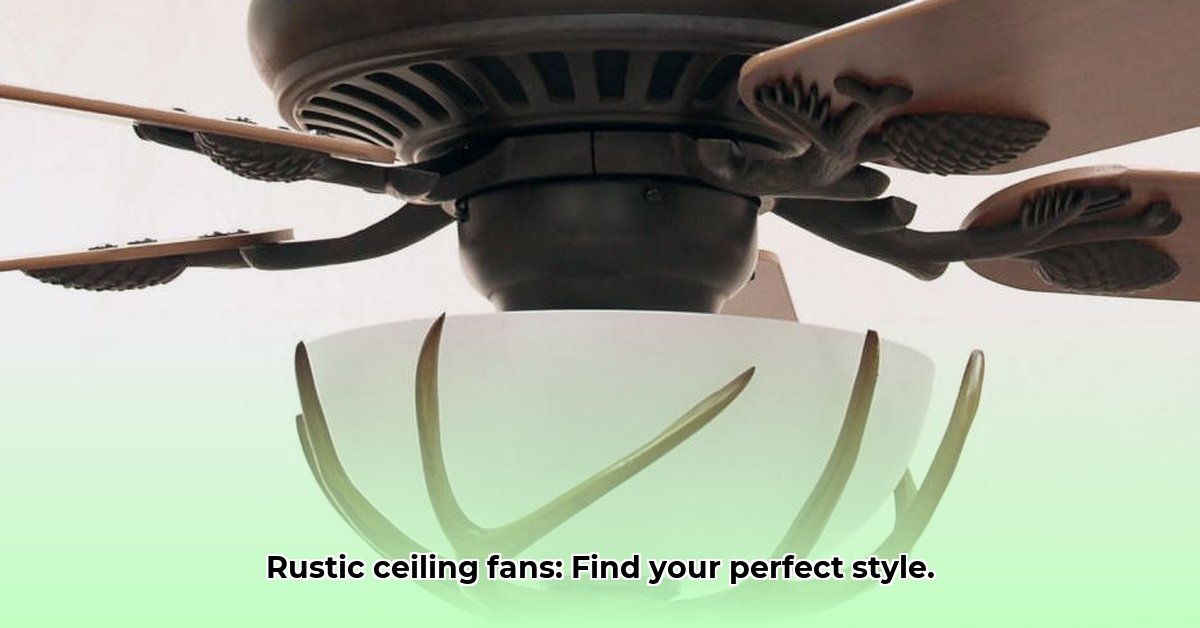Want a rustic-chic home? A rustic ceiling fan is the perfect finishing touch – stylish and functional. But with so many choices, picking the right one can be tough. This guide simplifies things, covering everything from understanding different rustic styles (modern farmhouse, rustic industrial, etc.) to choosing the right size and features for your room. We’ll help you figure out the best motor, lighting, and even installation, so you end up with a beautiful, efficient fan that’s perfect for your home. Whether you’re a DIY pro or a complete beginner, we’ll make sure you get the perfect rustic fan, and we’ll show you how to keep it looking great for years to come. Let’s get started on creating your dream space!
Find Your Perfect Rustic Ceiling Fan: A Style & Buying Guide
Choosing a ceiling fan might seem simple, but when you’re aiming for that perfect rustic charm, it gets a little more interesting! This guide will walk you through selecting the ideal rustic ceiling fan for your home, covering everything from style to installation and rustic home decor.
Defining “Rustic” for Your Ceiling Fan
What makes a ceiling fan “rustic”? It’s less about a strict definition and more about a feeling. Imagine the warmth of weathered wood, the subtle gleam of aged metal, a hint of old-world charm – that’s the essence of rustic. It’s wonderfully adaptable, too. You can have a sleek modern farmhouse design, the industrial grit of exposed metal, or the cozy comfort of a traditional country style. The possibilities are as varied as your home’s personality. The key? Choosing a style that speaks to you and complements your existing décor. Picture this: perhaps a fan with sleek metal blades against exposed brick, or maybe warm, slightly distressed wood blending seamlessly into a cozy living room. The right ceiling fan will truly elevate your space.
Exploring Rustic Ceiling Fan Styles
Think of your ceiling fan as the finishing touch, the perfect accent to your room’s overall design and the modern home. Several popular styles exist:
- Modern Farmhouse: This style emphasizes clean lines and simple designs, often featuring white or subtly painted wooden blades. Think airy and bright. Ideal for kitchens, sunrooms, and bedrooms seeking a light and fresh aesthetic.
- Rustic Industrial: This option leans into the raw, exposed look. Darker wood tones paired with metal accents create a sophisticated, edgy vibe. It fits perfectly in lofts or spaces with exposed brick or pipes. Great for living rooms, home offices, and creative studios.
- Traditional Country: This style offers a more ornate and detailed look, usually featuring stained wood with rich, darker finishes. It evokes a warm, nostalgic feel, perfect for creating a cozy atmosphere. Best suited for dens, libraries, and bedrooms aiming for a classic and inviting ambiance.
- Coastal Rustic: This style brings a lighter, airier feel with driftwood or pale wood blades. It’s perfect for spaces bathed in natural light and evokes relaxation and seaside charm. Wonderful for sunrooms, patios, and bedrooms, conjuring a breezy, vacation-like atmosphere.
Here’s a quick visual comparison to help you envision these styles:
| Style | Blade Material | Typical Finish | Overall Vibe | Common Room Placement |
|---|---|---|---|---|
| Modern Farmhouse | Light-colored wood | White, light gray | Clean, airy, bright | Kitchen, Sunroom |
| Rustic Industrial | Dark wood, metal | Black, bronze, dark gray | Edgy, sophisticated | Living Room, Home Office |
| Traditional Country | Dark wood | Stained, varnished | Warm, cozy, traditional | Den, Library |
| Coastal Rustic | Light wood, bamboo | Natural, whitewashed | Relaxed, breezy, bright | Sunroom, Patio |
Choosing the Right Rustic Ceiling Fan: A Buyer’s Guide
Now that you’ve got a handle on the styles, let’s dive into the practical considerations for selecting your perfect fan and find a ceiling fan for your home.
1. Room Size and Air Circulation: The size of your room directly impacts the fan size you’ll need. A larger room needs a larger fan to effectively circulate the air. Always check the manufacturer’s recommendations based on square footage. Here’s a general guideline:
- Rooms up to 75 square feet: 36-inch blade span
- Rooms between 76-144 square feet: 42-inch blade span
- Rooms between 144-225 square feet: 52-inch blade span
- Rooms larger than 225 square feet: 60-inch or larger blade span
Overly small fans will struggle, while overly large fans might look awkward.
2. Ceiling Height and Mounting: Ceiling height is crucial. Standard fans hang down a certain distance. Low ceilings (less than 8 feet) might necessitate a flush mount or low-profile fan to prevent head-bonking incidents! For ceilings 8-9 feet, a downrod of 6-12 inches is generally recommended. For ceilings taller than 9 feet, consider a downrod of 12 inches or longer. Consider the overall look and functionality when choosing the mounting type. Ensure at least 7 feet of clearance from the floor to the fan blades for safety and optimal airflow.
3. Lighting: Brightness and Energy Efficiency: Many rustic fans offer integrated lighting and ceiling fan with lights. LED lighting is generally the better choice; it’s far more energy-efficient and lasts significantly longer than incandescent bulbs. Check if the lighting offers dimming capabilities for mood setting. Look for fans with adjustable color temperature, allowing you to switch between warm and cool lighting tones. This adds convenience and helps manage the brightness level in your room. Consider the lumen output (brightness) of the lighting fixture to ensure it adequately illuminates the space.
4. Motor Type and Energy Efficiency: Energy efficiency is worth considering to save money on your electricity bill. Look for high-efficiency motors – often signified by an Energy Star rating. These motors use less energy while maintaining strong performance. DC motors are generally more energy-efficient and quieter than AC motors. You’ll find a higher initial cost with an energy efficient fan, but you’ll likely make up for it in the long run.
5. Installation: A Quick Overview: There are three main mounting options: standard, flush mount, and angled. The best option depends on your ceiling’s structure and the overall aesthetic you want to achieve. Ensure your electrical box is rated for ceiling fan use. While we can’t cover a complete DIY installation guide here, always remember to consult the manufacturer’s instructions – safety first! This includes double-checking the weight capacity of your ceiling joists. If you’re unsure about any aspect of the installation, reach out to a qualified electrician. Consider consulting local building codes and regulations before starting any electrical work.
Top Rustic Ceiling Fan Brands (and What to Look For)
While we aren’t naming specific brands here, it’s important to do your research. Compare different manufacturers: consider their design aesthetics, customer reviews, performance ratings, and warranty options. Look beyond the pretty pictures; delve into the specifics. A good warranty (at least 1-year on the motor and parts) is a sign of a manufacturer who stands behind their product’s quality. Check for certifications like UL Listed or ETL Listed, indicating the fan has been tested for safety.
Smart Features
Consider smart ceiling fans that offer Wi-Fi connectivity, smartphone app control, and voice assistant compatibility (e.g., Amazon Alexa, Google Assistant). These features allow you to adjust fan speed, lighting, and even set schedules remotely. Integration with smart home systems can enhance convenience and energy savings.
Blade Pitch
The blade pitch (angle of the blades) affects airflow. A steeper blade pitch generally moves more air, but it can also increase noise. Look for fans with a blade pitch between 12 and 15 degrees for optimal performance.
Remote Control
A remote control adds convenience, allowing you to adjust fan speed and lighting from anywhere in the room. Look for remotes with intuitive controls and a dedicated wall mount. Some remotes also offer features like a sleep timer or a breeze mode that simulates natural airflow.
Maintaining Your Rustic Charm
To keep your rustic ceiling fan looking and performing its best, a little regular maintenance goes a long way. Dusting is crucial; the blades accumulate dust surprisingly quickly. Periodic cleaning (following the manufacturer’s instructions) will ensure long-lasting performance and maintain its aesthetic appeal. Once a month, use a microfiber cloth or a vacuum cleaner with a brush attachment to gently remove dust from the blades and motor housing. Using a soft cloth and a gentle cleaner will keep your fan looking its best for years to come. Inspect the mounting hardware periodically to ensure it’s secure and tighten any loose screws.
By carefully considering the style, functionality, and your home’s specific needs, you can find the perfect rustic ceiling fan. Remember, it’s a blend of aesthetics and practicality – find the sweet spot where both shine!
Finding Your Perfect Rustic Ceiling Fan: A Style & Buying Guide
Key Takeaways:
- Farmhouse ceiling fans blend function and rustic aesthetics, using natural materials and ceiling fan styles.
- Airflow capacity, reversible motors, and integrated lighting are crucial features.
- Blade diameter affects airflow and room suitability; consider your ceiling height and room size when selecting a
- Colorful Backsplash Ideas: Brighten Your Kitchen With Tile - November 9, 2025
- Black Backsplash Ideas: Stylish Kitchen Transformations to Inspire You - November 8, 2025
- Dark Backsplash Ideas: Drama and Depth for Your Kitchen - November 7, 2025










